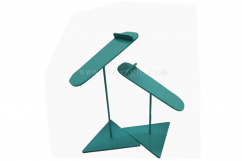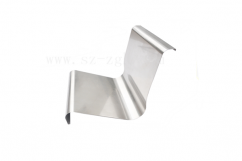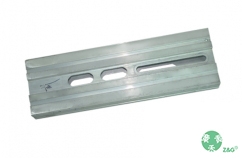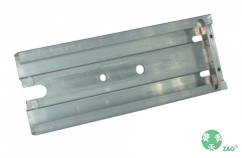Property and Structure of Stainless Steel
The properties and structures of stainless steel are mainly determined by various elements. At present, there are more than one hundred known chemical elements. The elements that have the greatest impact on the properties and structures of stainless steel include carbon, chromium, nickel, manganese, nitrogen, titanium, niobium, molybdenum, copper, aluminum, silicon, vanadium, tungsten, boron, etc. Due to the addition of these elements, the internal structure of the steel changes, so that the steel has special properties. In order to deepen our understanding of stainless steel, it is necessary for us to first understand the effects of various elements on the properties and structures of stainless steel.
1. Chromium is the basic element of stainless steel.
Chromium is the most basic element that determines the corrosion resistance of stainless steel. In the oxidizing medium, chromium can quickly form a layer of chromium rich oxide film on the surface of steel that is actually impermeable and insoluble to the corrosive medium. This oxide film is very dense and is basically firmly combined with the metal to protect the steel from further oxidation erosion by external media; Chromium can also effectively increase the electrode potential of steel. When the chromium content is not less than 12.5% atoms, the electrode potential of the steel will suddenly change from negative potential to positive electrode potential. Therefore, the corrosion resistance of steel can be significantly improved. The higher the chromium content, the better the corrosion resistance of the steel. When the chromium content reaches 25% and 37.5% atoms, the second and third abrupt changes will occur, making the steel have higher corrosion resistance.
2. Nickel alone cannot form stainless steel
The effect of nickel on corrosion resistance of stainless steel can be fully shown only when it is matched with chromium. For low carbon nickel steel to obtain pure austenite structure, the nickel content needs to reach 24%; In order to significantly change the corrosion resistance of steel in some media, the nickel content should be above 27%. Therefore, nickel cannot constitute stainless steel alone. Adding 9% nickel to the steel containing 18% chromium can make the steel obtain a single austenite structure at room temperature, improve the corrosion resistance of the steel to non oxidizing media (such as dilute sulfuric acid, hydrochloric acid, phosphoric acid, etc.), and improve the welding and cold bending process properties of the steel.
3. Manganese and Nitrogen -- Can Replace Nickel in Chromium Nickel Stainless Steel
Manganese and nitrogen have similar effects on nickel in stainless steel. The stabilizing austenite effect of manganese is half that of nickel, while the effect of nitrogen is much greater than that of nickel, about 40 times that of nickel. Therefore, manganese and nitrogen can replace nickel to obtain a single austenitic structure. However, the addition of manganese will reduce the corrosion resistance of stainless steel with low chromium content. At the same time, high manganese austenitic steel is not easy to machine. Therefore, manganese is not used alone in stainless steel, but only partially replaces nickel.
4. Carbon - dual in stainless steel
The content and distribution form of carbon in stainless steel, to a large extent, affect the performance and structure of stainless steel: on the one hand, carbon is a stable austenitic element, and plays a very important role, about 30 times as much as nickel. High carbon content (martensitic) stainless steel can fully accept quenching strengthening, which can greatly improve its strength in terms of mechanical properties; On the other hand, due to the great affinity between carbon and chromium, chromium, which takes up 17 times the amount of carbon in stainless steel, is combined with it to form chromium carbide. With the increase of carbon content in steel, more chromium forms carbide with carbon, which significantly reduces the corrosion resistance of steel. Therefore, in terms of strength and corrosion resistance, the role of carbon in stainless steel is contradictory. In practical application, in order to achieve the purpose of corrosion resistance, the carbon content of stainless steel is generally low, mostly about 0.1%. In order to further improve the corrosion resistance of steel, especially the ability to resist intergranular corrosion, ultra-low carbon stainless steel is often used, with the carbon content of 0.03% or less; However, the carbon content of stainless steel used for manufacturing rolling bearings, springs, tools, etc. is high, generally between 0.85% and 1.00%, due to the high hardness and wear resistance requirements. Such as 9Cr18 steel.
5. Titanium and Niobium -- It can prevent the intergranular corrosion of stainless steel
When the stainless steel is heated to 450~800 ℃, the chromium content near the grain boundary often decreases due to the precipitation of chromium carbide at the grain boundary, forming a chromium poor zone, which leads to the decrease of electrode potential near the grain boundary, thus causing electrochemical corrosion. This corrosion is called intergranular corrosion. Common examples are intergranular corrosion in the heat affected zone near the weld. However, titanium and niobium are strong carbide forming elements, and their affinity to carbon is much greater than chromium. When titanium or niobium is added to steel, carbon in steel can first form carbide with titanium or niobium, but not with chromium, so as to prevent intergranular corrosion near grain boundaries due to chromium depletion. Therefore, titanium and niobium are often used to fix carbon in steel, improve the ability of stainless steel to resist intergranular corrosion, and improve the weldability of steel.
The addition amount of titanium or niobium depends on the carbon content. Generally, the addition amount of titanium is 5 times of the carbon content and niobium is 8 times of the carbon content.
6. Molybdenum and copper can improve the corrosion resistance of some stainless steels to some media
Molybdenum and copper can improve the corrosion resistance of stainless steel to sulfuric acid, acetic acid and other corrosive media. Molybdenum can also significantly improve the corrosion resistance of chloride containing media (such as hydrochloric acid) and organic acids. However, stainless steel containing molybdenum should not be used in nitric acid. The corrosion rate of stainless steel containing molybdenum in boiling 65% nitric acid is twice that of stainless steel without molybdenum; The addition of copper to Cr Mn N stainless steel will accelerate the intergranular corrosion of stainless steel.
Molybdenum has an adverse effect on the steel to obtain a single austenite structure. Therefore, in order to make the steel have a single austenite structure after heat treatment in the steel containing molybdenum. The content of nickel in manganese and other elements should be increased accordingly.
7. Silicon and aluminum can improve the oxidation resistance of stainless steel
Silicon plays a significant role in improving the oxidation resistance of chromium steel. Steel containing 5% chromium and 1% silicon has the same oxidation resistance as 12% chromium steel. If the steel can resist oxidation at 1000 ℃, 22% chromium is needed when containing 0.5% silicon. If 2.5~3% silicon is added, only 12% chromium is needed. It is also reported that the oxidation resistance of Cr15Ni20 Cr Ni alloy can be equivalent to that of Cr15Ni60 Cr Ni alloy when 2.5% silicon is added to Cr15Ni20 Cr Ni steel.
Adding aluminum to high chromium steel can also significantly improve the oxidation resistance, which is similar to the function of adding silicon.
The purpose of adding silicon and aluminum to high chromium steel is to further improve the oxidation resistance of steel and to save chromium.
Although silicon and aluminum play a great role in improving the oxidation resistance of chromium steel, they also have many shortcomings. The main reason is that it increases the grain coarsening and brittleness tendency of steel.
8. The main function of tungsten and vanadium added to steel is to improve its thermal strength.
9. Boron
Adding 0.005% boron to high chromium ferritic stainless steel (Cr17MO2Ti) can improve the corrosion resistance of the steel in boiling 65% acetic acid; The hot plasticity of austenitic stainless steel can be improved by adding a small amount of boron (0.0006 ~ 0.0007%); Boron has a good effect on improving the thermal strength of steel, which can significantly improve the thermal strength of stainless steel; Chromium nickel austenitic stainless steel containing boron has special applications in the atomic energy industry.
However, boron in stainless steel will reduce the plasticity and impact toughness of steel.
10. In addition to the above elements, some stainless steels also add rare metal elements and rare earth elements to improve the properties of steel.
The basic element of stainless steel - chromium, the important element that affects the structure and properties of stainless steel - carbon, and the addition elements that improve the performance and structure of stainless steel - nickel, manganese, nitrogen, titanium, niobium, molybdenum, copper, silicon, aluminum, tungsten, vanadium, boron, etc. For stainless steel used in industry, there are several to more than ten kinds of alloy elements in many steels at the same time. When several elements coexist in stainless steel, the total effect of various elements determines the structure of stainless steel.
The influence of various elements on the structure of stainless steel can be summarized into two categories according to their commonness: one is the elements that form or stabilize austenite, which are carbon, nickel, manganese, nitrogen, copper, and carbon and nitrogen play the most important roles; The other is the elements that form ferrite. They are chromium, tungsten, molybdenum, niobium, silicon, titanium, vanadium, aluminum, etc. This type of element plays a more important role in forming ferrite. For example, when comparing chromium as 1, other elements play a more important role than chromium.
When these two kinds of elements coexist in stainless steel, the structure of stainless steel depends on the results of their interaction. If the elements that stabilize austenite play a major role, the structure of stainless steel is dominated by austenite, with little or no ferrite; If their effect is not enough to keep the austenite of the steel to room temperature, the unstable austenite will undergo martensitic transformation when it is cooled, and the steel structure is martensite; If the role of elements forming ferrite becomes the main aspect, the structure of steel is dominated by ferrite.
In addition to technological factors, the performance of stainless steel mainly depends on the composition of its internal structure, which is composed of the sum of various alloy elements in the steel. Therefore, in the final analysis, the performance of stainless steel is mainly determined by alloy elements.
Stainless steel containing only chromium element is usually called "stainless iron" and "chromium stainless steel" in industry. This kind of steel has magnetism, and their metallographic structure is ferrite, martensite or ferrite, martensite as the main duplex structure. This kind of steel has the ability to resist atmospheric and weak corrosion medium, or has higher corrosion resistance and oxidation resistance, or can be quenched. But their mechanical properties or technological properties are poor, and there are almost no shortcomings such as welding performance. This kind of steel is far from meeting the special requirements of industrial steel.
An appropriate amount of nickel is added to the matrix of chromium grade stainless steel. For example, after 8% nickel is added to the ferritic steel containing 18% chromium and low carbon (less than 0.12% carbon), the most ideal pure austenite structure can be obtained at room temperature. This steel is commonly referred to as non-magnetic stainless steel. Compared with ferritic or martensitic acid resistant stainless steel with the same chromium content, this kind of chromium nickel stainless steel not only has higher corrosion resistance, but also has good cold deformation hardening performance and welding performance. It has high plasticity and impact toughness at room temperature or low temperature, and is not magnetic. The disadvantage of this type of stainless steel is that its mechanical properties are relatively low and it is sensitive to intergranular corrosion and stress corrosion. However, it can be improved or eliminated by appropriate alloy additives or process measures.
In the base of chromium grade stainless steel, stainless steel with manganese as the main alloying element is added. It is commonly referred to as "chromium manganese nitrogen" stainless steel. Except that the strength of this type of stainless steel is higher than that of chrome nickel steel, its corrosion resistance and technological performance are not as good as those of chrome nickel austenitic stainless steel. In addition to individual cases, the production of this type of stainless steel is mainly to save expensive nickel element, so this type of steel is also called nickel saving stainless steel.








 What help do you need?
What help do you need?